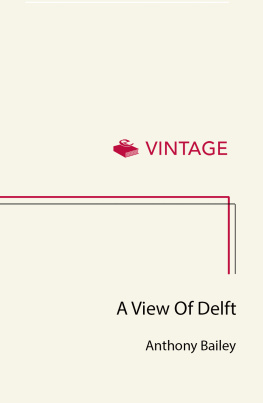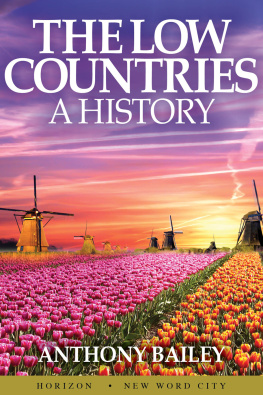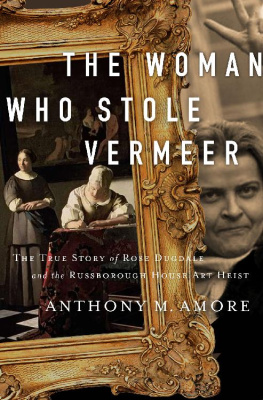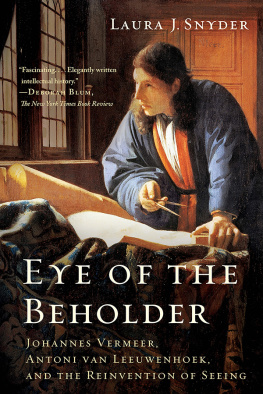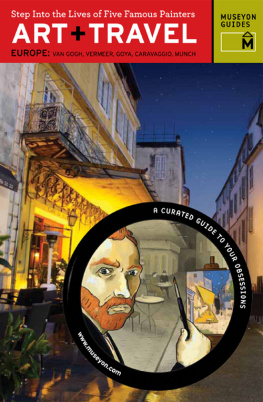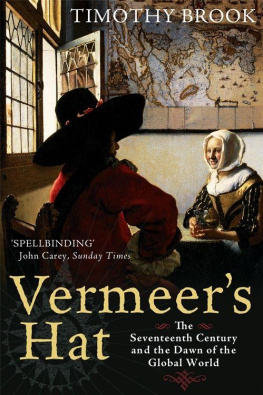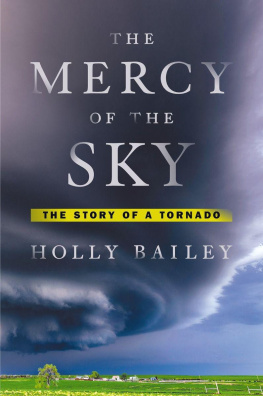Contents
About the Author
Anthony Bailey is the author of two studies of Rembrandt and a full-length life of Turner. For many years he was a writer for The New Yorker.
He was born in Portsmouth and studied history at Oxford University. His many books include a novel, Major Andr, and two much-acclaimed memoirs, America, Lost & Found and England, First & Last. He lives on the North Sea coast of Essex.
About the Book
Vermeer has always been considered the most elusive of great artists, but this book tracks him down in his home town. It takes the reader back to seventeenth-century Delft, in a piece of historical writing that does justice to its now timeless subject. Anthony Bailey makes use of the scholarly research that has accumulated in the last century, as well as recent findings, and then reaches beyond these facts to expose the hidden Vermeer. The result is a vivid, convincing portrait of the Protestant innkeepers son who married a prosperous Catholic girl and had 15 children of whom 11 survived. Vermeer died relatively young and left fewer than 40 pictures. Many of these pictures are indeed masterpieces, and Anthony Bailey examines the scientific expertise which lies behind their calm mystery. He introduces us to Vermeers colleagues and fellow-citizens, and charts his celebrity as it slowly spread out of Holland and encompassed the world. He examines Vermeers effect on many creative and destructive people, including Proust and Hitler. A View of Delft is a highly original attempt to get at Vermeers life and personality, by setting him imaginatively in the context of Delft, its culture and history.
Also by Anthony Bailey
Fiction
Making Progress
The Mother Tongue
Major Andr
Non-Fiction
The Inside Passage
Through the Great City
The Thousand Dollar Yacht
The Light in Holland
In the Village
A Concise History of the Low Countries
Rembrandts House
Acts of Union
Along the Edge of the Forest
Spring Jaunts
The Outer Banks
A Walk Through Wales
The Coast of Summer
Responses to Rembrandt
Standing in the Sun a Life of JMW Turner
Velzquez and The Surrender of Breda
Autobiography
America, Lost & Found
England, First & Last

This ebook is copyright material and must not be copied, reproduced, transferred, distributed, leased, licensed or publicly performed or used in any way except as specifically permitted inwriting by the publishers, as allowed under the terms and conditions under which it was purchased or as strictly permitted by applicable copyright law. Any unauthorised distribution or use of this text may be a direct infringement of the authors and publishers rights and those responsible may be liable in law accordingly.
Epub ISBN: 9781473522060
Version 1.0
www.randomhouse.co.uk
1 3 5 7 9 10 8 6 4 2
Pimlico, an imprint of Vintage Publishing,
20 Vauxhall Bridge Road,
London SW1V 2SA
Pimlico is part of the Penguin Random House group of companies whose addresses can be found at global.penguinrandomhouse.com.

Copyright Anthony Bailey 2001
Anthony Bailey has asserted his right to be identified as the author of this Work in accordance with the Copyright, Designs and Patents Act 1988
Quotation from A la Recherche du Temps Perdu by Marcel Proust, translated by C.K. Scott Moncrieff and Andreas Major, revised by Terence Kilmartin, are made by kind permission of Chatto & Windus, London, and Random House Inc., New York.
First published in Great Britain in 2001 by Chatto & Windus
www.vintage-books.co.uk
A CIP catalogue record for this book is available from the British Library
ISBN 9780712664721
Illustrations
The author and publishers are grateful to the owners of the following pictures for permission to reproduce them:
Black and white illustrations
Han van Meegeren, The Supper at Emmaus, c. 1937. Collection of Museum Boymans van Beuningen, Rotterdam.
Colour illustrations
Maps (by Reginald Piggott)
Acknowledgements
The search for Johannes Vermeer has now been going on for nearly a century and a half. As mentioned in the text, the French politician and writer Thophile Thor was one of the first explorers, but the Sphinx of Delft he found was very much a ghost lacking material attributes. Another Frenchman, Henri Havard, began to look in the 1870s in the as yet uncatalogued Delft archives for facts about Vermeers life, and his inquiries were followed by the investigations of Abraham Bredius, whose patrician standing was such that he was allowed to take original documents from the archives home to The Hague, where he occasionally underlined with blue pencil words he wanted to recall. In more recent years Vermeers trail has been pursued by a number of scholars, Dutch and foreign, professional and amateur. The roll of honour should include L.G.N. Bouricius, P.T.A. Swillens, A.J.J.M. van Peer (a primary schoolteacher), H.W. van Leeuwen (like Bouricius a Delft archivist), J.C. Hebbers, Rob Ruurs, C.J. Matthijs, and J.M. Montias. Montias, a former professor of economics at Yale University, began looking into the activities of the Delft Guild of St Luke in 1975, and although at that point he had (so he has written) no special interest in Vermeers life, gradually realised that there were new things to find out about Vermeer; he started to look more systematically for documents related to the artist and his relatives. What Montias has uncovered about Vermeers extended family and milieu greatly exceeds what he has discovered about the artist himself; but every writer on Vermeer is immensely indebted to him. Montiass Vermeer and his Milieu includes almost all of the extant documents.
My bibliography is an acknowledgement of my debt to many scholars and writers, but I also want to express my gratitude to those who have found things, sent me material, answered questions, translated documents, or pointed me in the right direction. They include Lief Achten; Fred Bachrach; Margot Bailey; Albert Blankert; Annette Boesveld; Christopher Brown; C.J. Fox; David Hockney; Buell Hollister; Susan Jowers; Walter Liedtke; Daniella Lokin; Jannes Meijer; Lies Meijer-Vonkeman; John Michael Montias; John Nash; Heleen Nieman; Neil Olson; Jacqueline Oud; Jenny Overton; Bridget Sojourner; Sarah Speight; Philip Steadman; Claudia Swan; Sarah Taft; John Updike; Marieke de Winkel; Graham Wrathmell; and the staffs of the archives in Delft and of the libraries in The Hague.
Authors Note
This book is an attempt to make accessible much of the research that has been done in the last century or so into the life of Johannes Vermeer. It tries to strike a balance between the questions art historians ask and the interests of the intelligent common reader. It puts Vermeers home town of Delft in the foreground of the inquiry. It assumes that a now world-famous painter was once a local artist, an innkeepers son who painted, a man who married and worked his way upwards while being a busy husband and a frequently harassed father of a large family. It is primarily a biography, an account of the life of an extremely elusive man, rather than a book about his paintings. However, since Vermeer was an artist, his work a vital byproduct of his life naturally comes in for examination, and helps us arrive at ideas about his personality. I accept the figure of thirty-five, possibly thirty-six, as the number of his known paintings.
Next page
